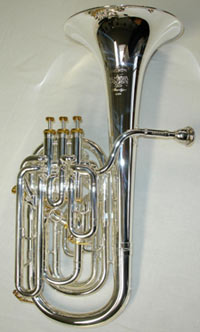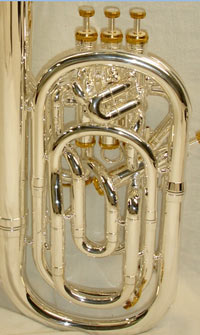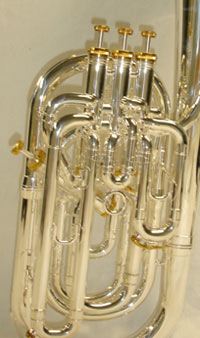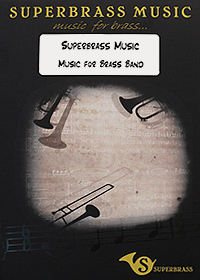4BR Roadtest: Besson Prestige Baritone 2056
4-Feb-20094BR has had its hands on the new Prestige Baritone from Besson. The makers say they have done wonders with it, so does it cut the mustard?
Introduction:
Instrument Review: Besson Prestige Baritone 2056
A little like a City of London stock analyst, Besson has been busy over the last year or so looking at their portfolio of instruments – investing in the body of products that they believe will make them the undisputed market leaders once again, pruning the dead wood and consigning the carcasses to history.
It has been a time consuming process – identifying the problems is the easy bit (and Besson have had their problems to address), making sure they can then tweak, enhance, or even start from scratch again, something else.
 So far the decisions that have been made have been pretty successful – demand for the new range of professional level instruments in particular has been healthy, even in market place that is currently awash with numerous top of the range models.
So far the decisions that have been made have been pretty successful – demand for the new range of professional level instruments in particular has been healthy, even in market place that is currently awash with numerous top of the range models.
The latest instrument to receive the overhaul treatment is the Besson baritone, which has had the expert eye of Steven Mead amongst others looking at the performance charts , design predictions and analising the data before it has been unleashed onto the market place.
Besson are confident that they have taken a radical decision in totally overhauling the previously popular and effective Besson 956, and believe their new Prestige 2056 has several new features that will undoubtedly make it the leader in its field.
4BR has had its hands on the instrument for a couple of weeks, courtesy of our friends at Normans Musical Instruments and has put it through our usual rigorous roadtest to find out if the claims are substantive or just a fancy bit of market advertising.
We look at four main areas: Build Quality/Design; Intonation; Ease of Blowing/Tone and Overall performance/Value for Money.
Marks are out of 25. So this is what we thought.
 Build Quality/Design:
Build Quality/Design:
The most immediate thing to strike you is the design of the new model. Whereas the old 956 looked a touch cramped and put together with the help of a well placed lump hammer or two, the new 2056 is a much more elegant instrument – very sleek and linear in appearance.
The good looks have been enhanced by the introduction of a bit of gold ‘bling’ on valve tops and bottom caps as well as with the waterkeys – and the good news is that it’s the proper stuff too – not something that has less carats than a rabbit stew and makes your fingers go green when you sweat a bit.
The more technically minded will notice that the fourth valve has been significantly repositioned at a better angle, making it easier to hold and operate.
The previous 4th valve on the 956 was more at a right angle to the body of the instrument, but the new placement allows the first finger of the left hand to be used with freedom and flexibility.
A close inspection also reveals a reshaping of some of the ‘internal’ tubing of the instrument, which has rid the instrument of its previous cramped plumbing arrangement.
Elsewhere we were impressed by the standard of the build quality. Struts, welds, silver plate finish, valve furniture and even the lyre holder have been put together with care – something that previous models fell down on.
The 4 bottom sprung stainless steel valves are slick and facile and fit very snugly into the casings.
There is no hint of extraneous valve noise due to some quality felts too – and the little black valve guides seem built to do the job intended. All in all, a bit of a joy.
With the receiving pipe well positioned the instrument felt balanced with a comfortable neutral feel in the playing position, although our guinea pig did comment that it took a bit of getting used to.
Overall: Impressive. We liked the way in which the previous problem areas have been totally revamped and not just given a quick face lift. Care and attention has been paid to the small details too.
MARKS: 23/25
 Intonation:
Intonation:
Previous Besson baritones were sometimes difficult animals to keep in tune – a touch feral in fact, and prone to wayward excesses.
Besson had quite a bit to address then, but seem to have come up trumps.
The tuning of the new instrument is a huge improvement over the old one - due we are told, to exhaustive testing and modifications to slide lengths.
Concerns over tuning have for a long time troubled baritone players and they have been forced into making changes of fingering to get the notes close to the correct pitch.
The 2056 will make playing in tune so much easier, especially as the compensating system through the third slide on the back on the instrument is now at the correct length - it was previously far too short.
The improvements now mean that the low chromatic scale from bottom C to pedal C is very much in tune. In the past the lowest notes, using multiple valve combinations were very sharp, but the extra length has given the instrument a truer intonation feel.
No real problems in the mid and top ranges either (would a trigger mechanism benefit the instrument though?) even when there is a need to pump the air through.
Overall: Another major improvement on the old model and as good as we have come across with other leading makers.
MARKS: 23/25
 Ease of Blowing/Tone:
Ease of Blowing/Tone:
Baritones are not mini euphoniums or bass tenor horns. The beauty of the instrument remains its unique sound – a very British sound it must be said - slightly plump and rounded with a real hint of darkness at its heart.
At full tilt it must remain vibrant and bright, retaining its clarity and defined tonal edge.
Besson state that the tubing of this instrument has been made in a new way, using high pressure water techniques, resulting in more resonance than ever before (they say up to 30%).
However it is made the new 2056 baritone does feel remarkably free blowing (perhaps due to the new less cramped configuration).
We found that there was a lovely plumby richness of tone as well as a much improved precision in the high and low registers. The notes around and above end of the register play with more freedom, and responded well to dynamic extremes.
We felt you could give the instrument a good bit of welly and still be found wanting, whilst it didn't lose its focus when you needed to be as quiet as a Buddist monk.
Even down in the dead man territory way below the stave, the instrument kept its tonal integrity. Our guinea pig was impressed.
Overall: Very good stuff. There was a freedom about the ease of blowing at both ends of the dynamic spectrum as well as the top and bottom ends of the instruments true range.
MARKS: 23/25
Overall Performance/Value for Money:
Now comes the crux. What with the value of the pound falling through the floor, this is not a cheap instrument.
However, in this day and age that is not a bad thing as it makes you much more aware of what you expect to get for your hard earned money.
And the Besson gives you one hell of a lot.
Not only does it look the part – it plays the part too. From the excellent build quality to the free blowing sound, accurate intonation and tonal integrity.
It is an instrument aimed at the very top end performer, and the top end performer will be very pleased to have one in their grasp.
It comes with the usual Besson package of extras with an Alliance mouthpiece, cloth etc. The case is very good and offers excellent protection (much needed at this price) and although we would like to see the 2056 slightly cheaper, you can still get pretty good discounts if you ask.
Overall: A premier instrument at a premier price for sure, but if you are serious about playing the baritone to a high standard then the new 2056 is a very solid investment.
MARKS: 22/25
Overall comment: Any instrument that scores over 90 points on the 4BR roadtest is one that we feel is of the highest quality – and this one is.
No real gripes, except perhaps that at present it is an expensive bit of kit. That said, you certainly get what you pay for – and true quality doesn’t come cheap even at the best of times.
Overall Total:
Build Quality and Design: 23 points
Intonation: 23 points
Ease of Blowing and Tonal quality: 23 points
Overall performance and value for money: 22 points
Overall Score: 91 points
 Specifications:
Specifications:
Cost: Approx £3,220 (inc VAT)
Instrument specifications
Key: Bb
Bore: .54" (13.8mm)
Bell diameter: 9.1/2" (241.3mm)
Valves: 4 bottom sprung stainless steel
Compensating system
Finishes: lacquer or bright silverplate
Supplied outfit, in case with Alliance mouthpiece in leather case and mouthpiece









